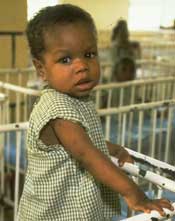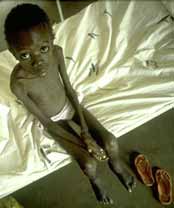|
Fact Sheet 5 Care of HIV infected and affected children
|
|||||||||||||||||||||||||
|
|||||||||||||||||||||||||
Introduction:The number of children under 15 who have lived or are living with HIV since the start of the epidemic in the late 1970's has reached about 4.8 million - 3.6 million of them have already died. Nearly 600 000 children were infected with HIV in 1999, mostly through their mothers before or during birth or through breast feeding (vertical transmission). |
|
||||||||||||||||||||||||
The lives of children
who do not have HIV themselves are affected when family members
have AIDS. Families face increased poverty and stress because adults
have to leave their paid employment, or are too sick to farm their
land. Women may be ill themselves, as well as caring for other sick
family members and looking after young children (Fact Sheet 10).
|
|||||||||||||||||||||||||
|
HIV-infected children have an increased frequency of common childhood infections such as ear infections and pneumonia. In developing countries, diseases such as chronic gastroenteritis and tuberculosis are also frequent. In HIV-infected infants, the symptoms common to many treatable conditions, such as recurrent fever, diarrhoea and generalized dermatitis, tend to be more persistent and severe. Moreover, HIV-infected infants do not respond as well to treatment and are likely to suffer life-threatening complications. Enlarged lymph nodes and an enlarged liver are common in children infected with HIV. Opportunistic infections occur as the immune system becomes more affected, and most of these children have some type of neurological involvement, such as developmental delay or infection in the brain. Fact Sheet 4 provides an overview of the common medical, pharmaceutical, and nursing care treatments for opportunistic infections in adults that can be adapted to the care of infants and children. When administering medicines, it is important to consider the amount to be prescribed (depending on the infant/child's size and body weight), and its suitability for use in children. |
|
||||||||||||||||||||||||
The course of HIV in infants/childrenThe majority of
infected infants develop disease during the first year of life and
have a high mortality rate. With recent research and new antiretroviral
therapies (ARVs), there has been significant improvement to child
mortality in countries where this treatment is available and accessible.
Making a diagnosis of AIDS in children when HIV testing is not availableIn infected women, the maternal HIV antibody is passively transmitted across the placenta to the fetus during pregnancy (Fact Sheet 10). This antibody can persist in the infant for as long as 18 months. Consequently, during this period, the detection of HIV antibody in infants does not necessarily mean that an infant is infected. Therefore, a case definition for AIDS is made in the presence of at least 2 major, and 2 minor signs.
Please note: Confirmed HIV infection in the mother counts as a minor criterion.
|
|||||||||||||||||||||||||
|
Paediatric infection |
Treatment |
|
Oral thrush (Often recurs after treatment and can be the first indication of HIV infection) |
Treat with gentian violet application, polyvidone iodine and chlorhexidine mouthwash, and antifungal tablets and lozenges (depending on child's age) |
|
Other skin diseases |
Calamine, topical steroids, antibotics orally or topically |
|
Unexplained fever |
Paracetamol; aspirin (in children older than 6 years of age) |
|
Sexually transmitted diseases in the newborn |
Antibiotics such as benzylpenicillin, kanamycin, erythromycin and others have been found to be effective for newborn treatment of syphilis, gonorrhea, and chlamydia |
|
Otitis media |
Broad Spectrum antibiotics |
Emphasize early diagnosis and treatment of suspected TB for all family
TB is one of the most common and deadly opportunistic infections and the HIV positive child is very susceptible to contracting this disease. Every effort should be made to ensure that TB prevention and treatment is available to family members. (See Fact Sheets 4 and 13)
Immunize according to standard schedules
All infants and children should
be immunized according to standard schedules. The only exception
is that infants with clinical symptoms of HIV infection should not
be given tuberculosis vaccine (BCG). It is important that correct
sterilization procedures for immunization equipment be strictly
followed (See Fact Sheet 11 on Universal Precautions).
Ensure the child has good quality of life
Most infants of HIV infected
mothers are not infected with HIV (Fact Sheet 10). In addition,
many of those who are infected will have months of asymptomatic
life. Some will live for years without developing symptoms. Every
effort should be made by members of the child's family and by the
health care professional to help the HIV-infected child to lead
as normal a life as possible.
Basic nursing care for
the HIV-infected child with an opportunistic infection
Infection control
Maintain good hygiene. Always wash hands before and after care. Make
sure linen nappies and other supplies are well washed with soap
and water. Burn rubbish or dispose of in containers. Avoid contact
with blood and other body fluids and wash hands immediately after
handling soiled articles. (See Fact Sheet 11 on Universal Precautions
)
Skin problems
Wash open sores with soap and water, and keep the area dry. Salty
water can be used for cleansing. Use medical treatment, such as
prescribed ointment or salve, where available. Local remedies, oils,
and calamine lotion might also be helpful.
Sore mouth
and throat
Rinse the child's mouth with warm water at least three times daily.
Give soft foods that are not too spicy.
Fevers
and pain
Rinse body in cool water with a clean cloth or wipe
skin with wet cloths. Encourage the child to drink more fluids (water,
tea, broth, or juice) than usual. Remove thick clothing or too many
blankets. Use antipyretics and analgesics such as aspirin, paracetamol,
acetaminophen, etc.
Cough
Lift the child's head and upper body on pillows to
facilitate breathing, or assist the child to sit up. Place the child
where she/he can get fresh air. Vapourisers, humidifiers can provide
symptomatic relief.
Diarrhoea
Treat diarrhoea immediately to avoid dehydration, using
either oral rehydration salts (ORS), or intravenous therapy in severe
cases of dehydration. Ensure that the child drinks more than usual,
and continues to take easily digestible nourishment. Cleanse the
anus and buttocks after each bowel movement with warm soap and water
and keep the skin dry and clean. Antibiotics used for other infections
can worsen the diarrhoea. Remember to wear gloves or other protective
covering when handling faecally contaminated material (Fact Sheet
11).
Local Remedies
There are often local remedies that alleviate fevers, pains, coughs,
and cleanse sores and abscesses. These local remedies can be very
helpful in relieving many of the symptoms associated with opportunistic
infections. In many countries, traditional healers and women's associations
or home care programs compile information on local remedies which
alleviate symptoms and discomfort.
Assessing the family's
ability to care for a child with HIV and HIV-related illness
The ability of
a family to care for a child with HIV-infection or related illness
is affected by their socio-economic status and their knowledge and
attitudes about HIV infection. The following questions will help
the health care worker to determine what care can be expected from
family members and what care must be obtained from other sources.
|
Children orphaned by
AIDS
Approximately 8.2 million children around the world have been orphaned by the HIV/AIDS epidemic. AIDS orphans, defined as children who have lost their mother or both parents to AIDS before reaching the age of 15, are predicted to number 41 million worldwide by 2010. Nine out of ten (90%) maternal orphans are presently living in sub Saharan Africa. The extended family system, which would traditionally provide support for orphans, is greatly strained in communities most affected by AIDS. This is especially true in populations which migrate.
|
Nurses and midwives can play an important role in orphan care. This care could include direct physical care, being an advocate on behalf of the child, and helping to influence policy changes to respect the rights and dignity of children. |
When children are cared for by other family members, this places an added financial burden on these care givers. After their parent's death, children can lose their rights to the family land or house. Without education, work skills or family support, children may end up living on the streets. These children are especially vulnerable, often becoming sexually active at an early age and at risk from HIV themselves (Fact Sheet 10). Poverty is an overwhelming problem. These orphans not only lack money, but basics such as clean water, drugs, food, shelter and medical supplies. They do not have information about how to protect themselves, and have poor access to doctors, nurses, and other health care workers and facilities. Finally, these orphans often lack human rights and dignity. The magnitude of this problem will have to be addressed at international, national, local, and community levels. Government, non-governmental organizations (NGO) and other institutions and organizations will have to combine their efforts to provide effective programs and strategies to care for orphaned children. Nurses and midwives can play an important role in orphan care. This care could include direct physical care, being an advocate on behalf of the child, and helping to influence policy changes to respect the rights and dignity of children.
Strategies for the care
of orphaned children
| Strategies for the care of orphaned children include the following, in order of preference: |
|
|
Questions for reflection
and discussion
|
|
What
are the most common symptoms in HIV-infected children? How
can you treat these symptoms? |
|
References
|
|
Caring for
Children. AIDS ACTION (27), AHRTAG, 1994-95 Gilks, C. et al.
(1998). Sexual health and health care: Care and support for
people with HIV/AIDS in resource-poor settings. Department
of International Development (DFID), London. |

